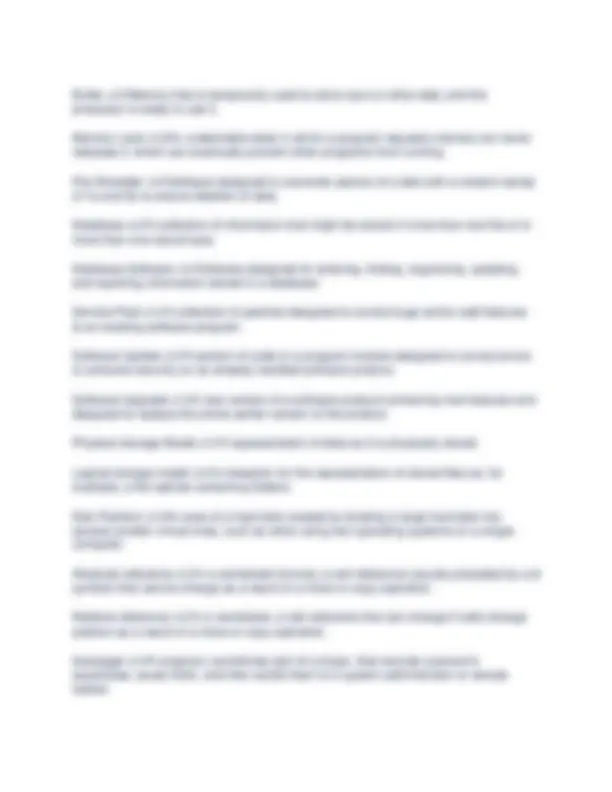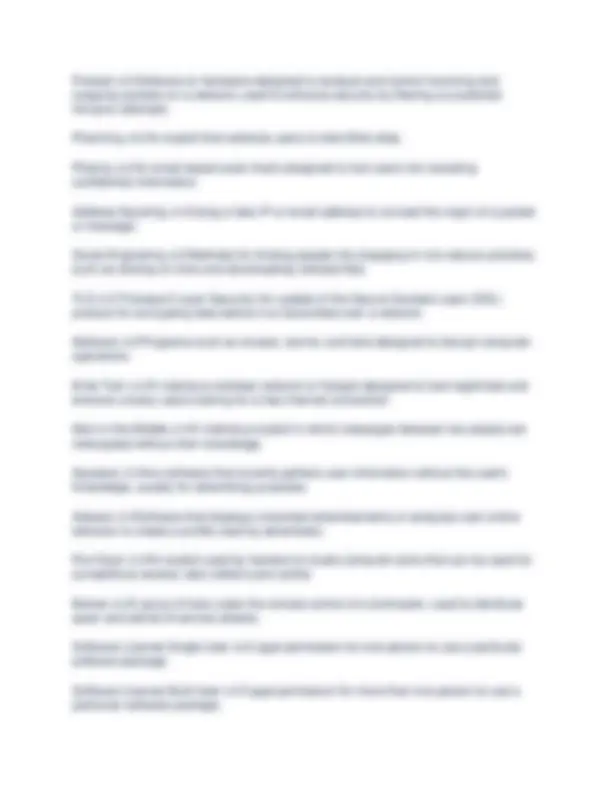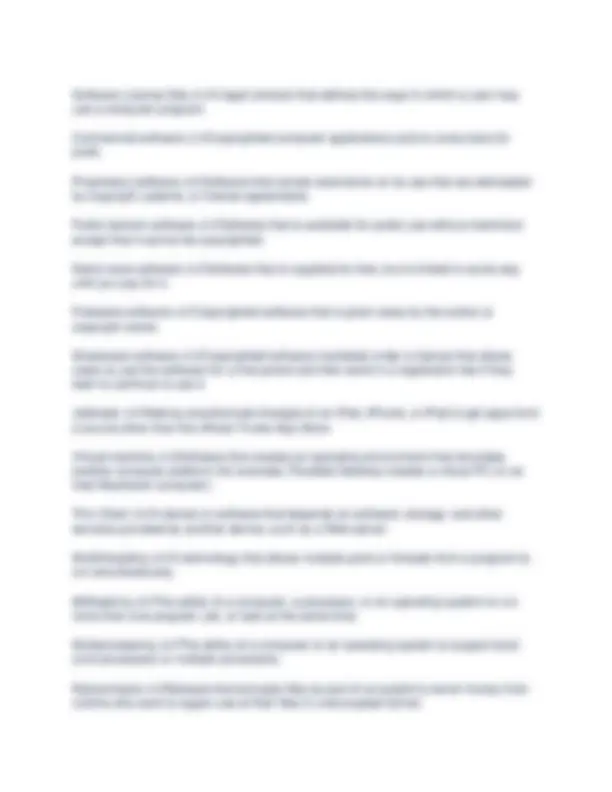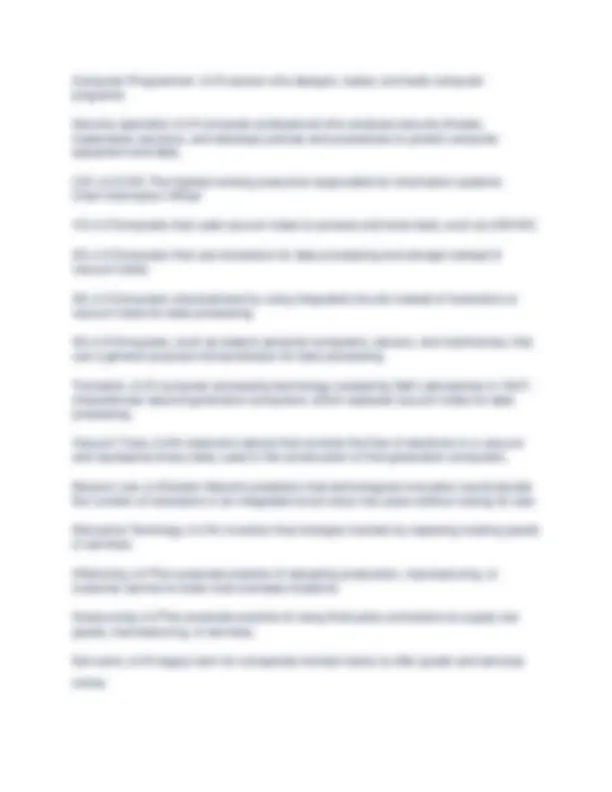






Study with the several resources on Docsity

Earn points by helping other students or get them with a premium plan


Prepare for your exams
Study with the several resources on Docsity

Earn points to download
Earn points by helping other students or get them with a premium plan
Community
Ask the community for help and clear up your study doubts
Discover the best universities in your country according to Docsity users
Free resources
Download our free guides on studying techniques, anxiety management strategies, and thesis advice from Docsity tutors
A comprehensive overview of key it concepts and definitions relevant to insy 2303 exam 2. It covers essential topics such as email protocols, network technologies, software licensing, security threats, and operating system fundamentals. Particularly useful for students preparing for the exam, offering a concise and organized review of important concepts.
Typology: Exams
1 / 8

This page cannot be seen from the preview
Don't miss anything!





SMTP ✔✔(Simple Mail Transfer Protocol) A communications protocol used to send email across a network or the Internet. POP3 ✔✔(Post Office Protocol version 3) A standard for retrieving email messages from an email server. IMAP ✔✔(Internet Message Access Protocol) A protocol similar to POP that is used to retrieve email messages from an email server, but offers additional features, such as choosing which emails to download from the server. VOIP ✔✔(Voice over Internet Protocol) Hardware, software, and protocols used to make telephone-style calls over the Internet. Also referred to as Internet telephony. Webmail ✔✔An email system that allows users to access email messages using a browser. Asynchronous ✔✔In the context of communications, such as email and text messaging, both parties need not be online at the same time. Synchronous ✔✔A communications mode, such as VoIP, in which participants must be online at the same time. Store-and-forward Technology ✔✔A technology used by communications networks in which a message, such as an email, is temporarily held in storage on a server until it is requested by a client computer. RSS Reader ✔✔Software that can be used to set up and access an RSS feed. Public Domain ✔✔Material that is not subject to copyright restrictions on its use and distribution. Copyright ✔✔A form of legal protection that grants certain exclusive rights to the work's creator or the owner of the copyright. Trademark ✔✔A logo symbol or word used to represent a business. Intellectual property ✔✔A legal concept that refers to ownership of intangible information, such as ideas.
IP Address ✔✔private IP address- An IP address that cannot be routed over the Internet. public IP address- IP addresses that can be routed over the Internet (as opposed to private IP addresses that cannot) (Internet Protocol) One of the main protocols of TCP/IP; responsible for addressing packets so that they can be routed to their destinations; IPv4 offers 32-bit addresses whereas IPv6 offers 128-bit addresses. Metadata Tag ✔✔Data that contains information about other data; file tags are an example of metadata. Hotspot Triangulation ✔✔The process of locating a device based on its distance from various hotspot servers. User Interface ✔✔The software and hardware that enable people to interact with computers. Pirated Software ✔✔Software that is copied, sold, or distributed without permission from the copyright holder. Open Sources Software ✔✔Software that includes its source code, allowing programmers to modify and improve it. Executable File ✔✔A file, usually with an .exe extension, containing instructions that tell a computer how to perform a specific task. EULA ✔✔(end-user license agreements) A type of software license that appears on the computer screen when software is being installed and prompts the user to accept or decline. Portable Software ✔✔Software designed to be stored on a flash drive or CD and does not require installation before it is used. Local Application ✔✔Software that is stored on a local device and loaded from there into RAM when it runs. Server Operating System ✔✔A type of operating system, sometimes called a network operating system, that provides management tools for distributed networks, email servers, and Web hosting sites. Kernel ✔✔The core module of an operating system that typically manages memory, processes, tasks, and storage devices.
Firewall ✔✔Software or hardware designed to analyze and control incoming and outgoing packets on a network; used to enhance security by filtering out potential intrusion attempts. Pharming ✔✔An exploit that redirects users to fake Web sites. Phising ✔✔An email-based scam that's designed to fool users into revealing confidential information. Address Spoofnig ✔✔Using a fake IP or email address to conceal the origin of a packet or message. Social Enginering ✔✔Methods for tricking people into engaging in non-secure activities, such as clicking on links and downloading infected files. TLS ✔✔(Transport Layer Security) An update of the Secure Sockets Layer (SSL) protocol for encrypting data before it is transmitted over a network. Malware ✔✔Programs such as viruses, worms, and bots designed to disrupt computer operations. Evile Twin ✔✔A malicious wireless network or hotspot designed to look legitimate and ensnare unwary users looking for a free Internet connection. Man-in-the-Middle ✔✔A malicious exploit in which messages between two people are intercepted without their knowledge. Spyware ✔✔Any software that covertly gathers user information without the user's knowledge, usually for advertising purposes. Adware ✔✔Software that displays unwanted advertisements or analyzes user online behavior to create a profile used by advertisers. Port Scan ✔✔An exploit used by hackers to locate computer ports that can be used for surreptitious access; also called a port probe. Botnet ✔✔A group of bots under the remote control of a botmaster, used to distribute spam and denial-of-service attacks. Software License Single User ✔✔Legal permission for one person to use a particular software package. Software Licence Multi-User ✔✔Legal permission for more than one person to use a particular software package.
Software Licence Site ✔✔A legal contract that defines the ways in which a user may use a computer program. Commercial software ✔✔Copyrighted computer applications sold to consumers for profit. Proprietary software ✔✔Software that carries restrictions on its use that are delineated by copyright, patents, or license agreements. Public domain software ✔✔Software that is available for public use without restriction except that it cannot be copyrighted. Demo ware software ✔✔Software that is supplied for free, but is limited in some way until you pay for it. Freeware software ✔✔Copyrighted software that is given away by the author or copyright owner. Shareware software ✔✔Copyrighted software marketed under a license that allows users to use the software for a trial period and then send in a registration fee if they wish to continue to use it. Jailbreak ✔✔Making unauthorized changes to an iPod, iPhone, or iPad to get apps from a source other than the official iTunes App Store. Virtual machine ✔✔Software that creates an operating environment that emulates another computer platform (for example, Parallels Desktop creates a virtual PC on an Intel Macintosh computer). Thin Client ✔✔A device or software that depends on software, storage, and other services provided by another device, such as a Web server. Multithreading ✔✔A technology that allows multiple parts or threads from a program to run simultaneously. Miltitasking ✔✔The ability of a computer, a processor, or an operating system to run more than one program, job, or task at the same time. Multiprocessing ✔✔The ability of a computer or an operating system to support dual- core processors or multiple processors. Ransomware ✔✔Malware that encrypts files as part of an exploit to extort money from victims who want to regain use of their files in unencrypted format.
Cryptographic Algorithim ✔✔A specific procedure for encrypting and decrypting data. Encryption ✔✔The process of scrambling or hiding information so that it cannot be understood without the key necessary to change it back into its original form. Decryption ✔✔The process of removing the encryption to produce clear text. Plaintext ✔✔An original, unencrypted message. Ciphertext ✔✔An encrypted message. Digital Certificate ✔✔A file that verifies the identity of a device, usually used in the context of network-based servers sending an encryption key to a client device. Confidentiality ✔✔The obligation not to disclose willingly any information obtained in confidence. Code of Ethics ✔✔A set of guidelines designed to help professionals make on-the-job ethical decisions. Information Techonlogy ✔✔(1) A degree program that focuses on the computer equipment and software used by businesses and organizations. (2) The use of computers and software to manipulate data. Comuter Science ✔✔A career field that focuses on developing fast and efficient computers from their construction to their programming and operating systems. Software Engineer ✔✔The process of developing software using systematic mathematical, engineering, and management techniques. Systems Analyst ✔✔A computer professional responsible for analyzing requirements, designing information systems, and supervising the implementation of new information systems. Computer Operator ✔✔A computer professional who works directly with and maintains mainframe computers or server arrays. Network administaor ✔✔The person responsible for configuring and monitoring a computer network. Database Administrator ✔✔A person who supervises database design, development, testing, and maintenance.
Computer Programmer ✔✔A person who designs, codes, and tests computer programs. Security specialist ✔✔A computer professional who analyzes security threats, implements solutions, and develops policies and procedures to protect computer equipment and data. CIO ✔✔(CIO) The highest-ranking executive responsible for information systems. Chief Information Officer 1G ✔✔Computers that used vacuum tubes to process and store data, such as UNIVAC. 2G ✔✔Computers that use transistors for data processing and storage instead of vacuum tubes. 3G ✔✔Computers characterized by using integrated circuits instead of transistors or vacuum tubes for data processing. 4G ✔✔Computers, such as today's personal computers, servers, and mainframes, that use a general-purpose microprocessor for data processing. Transistor ✔✔A computer processing technology created by Bell Laboratories in 1947; characterizes second-generation computers, which replaced vacuum tubes for data processing. Vacuum Tube ✔✔An electronic device that controls the flow of electrons in a vacuum and represents binary data; used in the construction of first-generation computers. Moore's Law ✔✔Gordon Moore's prediction that technological innovation would double the number of transistors in an integrated circuit every two years without raising its cost. Disruptive Technlogy ✔✔An invention that changes markets by replacing existing goods or services. Offshoring ✔✔The corporate practice of relocating production, manufacturing, or customer service to lower-cost overseas locations. Outsourcnig ✔✔The corporate practice of using third-party contractors to supply raw goods, manufacturing, or services. Dot-coms ✔✔A legacy term for companies formed mainly to offer goods and services online.